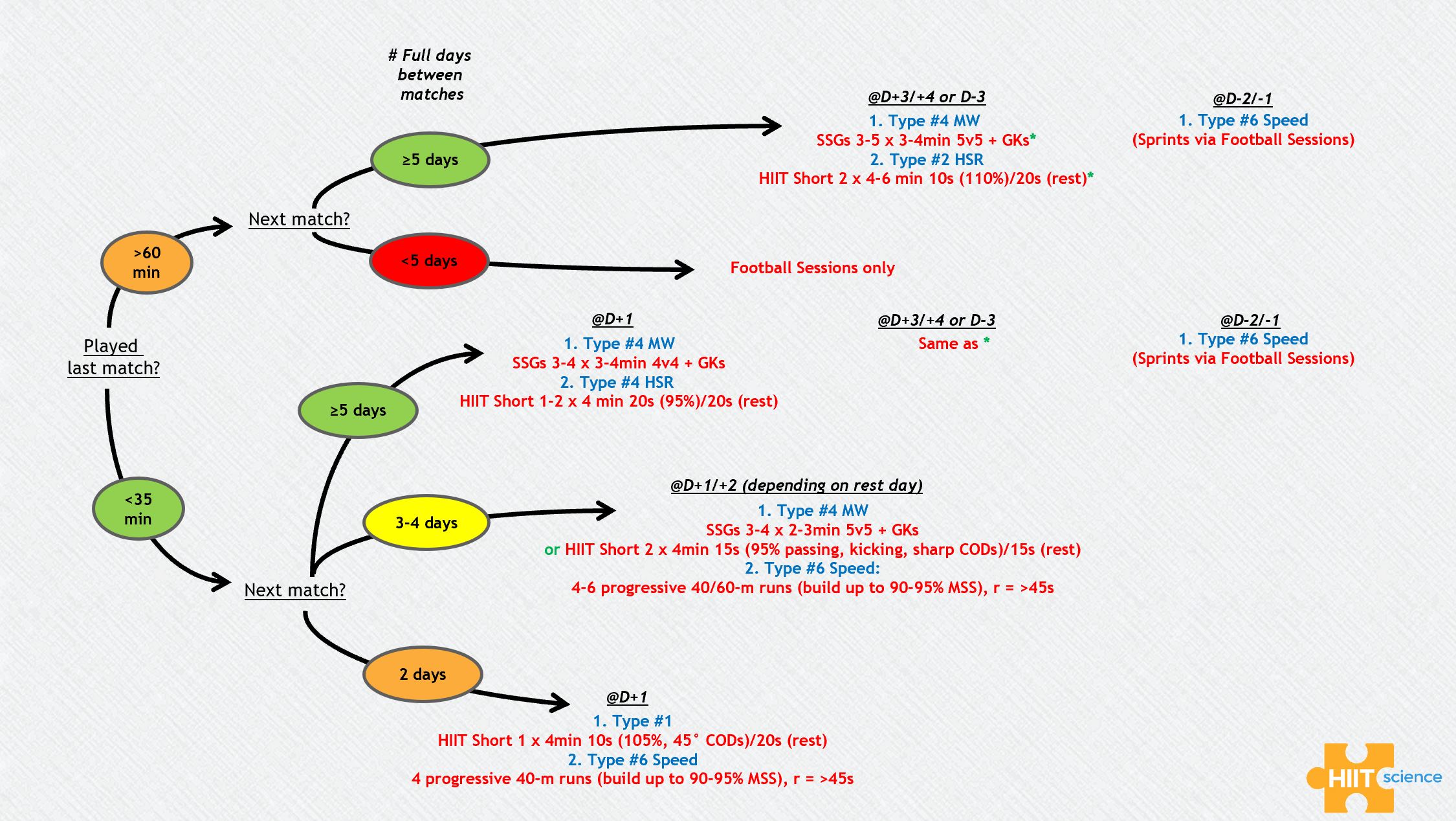Following the recent
post and article (1) on high-speed running (HSR) management, I have since written a
second short opinion piece for Sport Performance & Science Reports (2), where I offer further guidelines for coaches and practitioners for programming HSR and MW sequences in relation to technical training content and match schedules (i.e., different weekly microcycles). As most agree, the management of HSR forms a critical piece of the training program puzzle that we must consider from both a performance and injury mitigation perspective. Regular HSR supplementation helps maintain a stable HSR load (1), which indirectly
limits the occurrence of spikes and in turn, may lower injury risk (3). Beyond simply performing high-intensity interval training (HIIT, generally run around 18-22 km/h), sprinting all-out (4) or at least reaching close to top speed (5) is also needed to hit the full range of a player’s high-speed ability. In fact, while many fear the implementation of maximal sprinting during practice to avoid acute muscular strain, the reality is that sprinting itself is likely more the solution over any potential problem (4). In fact, typical strength work, reaching less than 75% of maximal EMG levels, is unlikely intense enough to replicate all-out sprint demands (6). For that reason, my friend and colleague,
JB Morin has long
suggested that sprint-specific neuromuscular demands be a non-negotiable part of any high-level program (
4).
While the management of HSR may essentially protect hamstring integrity, the importance of so-called mechanical work (MW, accelerations, decelerations and changes of direction) cannot be overlooked in the context of protecting other important muscles groups (i.e., quads, gluts and adductors). All this is, of course, easier said than done, with the actual programming of these specific locomotor loads requiring
particular attention to typical soccer training content, match demands and timing.
In this
short opinion piece (2), I discuss some programming consideration of HSR and MW in relation to the technical sequence on the same training session (i.e., the within-session puzzle piece). As
emphasized by Paul recently, the first aspect to consider when selecting HIIT types (i.e., physiological targets) and formats (i.e., actual sequences) is the neuromuscular demands of the tactical and technical sequences programmed within the same day or session (Figure 1). When a tactical session already involves large volumes of HSR, the best option to avoid overload of the posterior chain (and especially hamstrings) is likely to program either a run-based Type #1 HIIT (with low overall neuromuscular load) or a small-sided game with high MW demand (in this case, a complimentary load on the glutes, adductors and quads). In contrast, when the goal is to overload the posterior chain (such as when preparing for the worst-case scenario of match locomotor demands (8)), a Type #2 HIIT sequence targeting HSR is also a good option (9). Finally, in the context of a technical/tactical session already involving a high MW load, using a supplementary HIIT sequence involving HSR is another good choice for avoiding overload, since it will likely work different muscles groups compared to those of the technical/tactical sequence.

Figure 1. Typical framework for selecting the neuromuscular targets of a HIIT sequence in relation to the demands of the soccer-specific sequences of the same day/session. If the soccer-specific sequences already include HSR, HIIT may be more oriented towards 1) low or no additional neuromuscular load (Type #1) or 2) MW (Type #4) avoiding overload on the same muscle groups. Conversely, if the soccer-specific content already targets MW, HIIT could include 1) little or no MW (Type #1) or HSR (Type #2). HIIT Types refer to the physiological objectives of the sequences, as shown in Figure 1. From (7).
Second, in addition to the demands of technical sequences, participation in matches and the time between consecutive matches needs to be considered (i.e., between-match puzzle). This aspect, considering the training dynamics between matches, requires a broader understanding of the entire program, and needs to take into consideration the previous match’s locomotor load. Figure 2 shows the different training scenarios with various levels of HSR and MW loads, which are dictated by both the amount of work performed during the preceding match (overall, related to minutes played, player profile and position (1)), and the number of days before the next match. Logically, the more minutes played in the preceding game, and the shorter the between-match microcycle, the less the need for HSR and MW supplementation. For starters that played a full game, there is likely no need for any supplementation when games are separated by less than 5 days. While at the other end of the spectrum, substitute players having more than 5 days to train before their next game should likely perform the full range of HIIT weapons (Type #4, in the form of run-based HIIT and SSGs targeting both HSR and MW), together with high speed-top ups in the form of challenging sprints (Figure 2).

Figure 2. Decision process when it comes to programming locomotor loads, e.g. high-intensity intermittent training (HIIT) including high-speed running (HSR) and/or mechanical work (MW) and sprint work, with respect to competition participation and match microcycle. Note that only those specific sequences are shown, with most sessions also including technical and tactical components and likely possession games. SSGs: small-sided games. The different HIIT types are those presented in Figure 1. Note that for all HIIT Types involving a high neuromuscular strain, possible variations exist, i.e. more oriented toward HSR (likely associated with a greater strain on hamstring muscles) or MW (likely associated with a greater strain of quadriceps, adductors and gluteus muscles). Type #1 can be achieved for example using 45°-CODs, which is likely the best option to reduce overall neuromuscular load (decreased absolute running velocity without the need to apply large forces to change direction, resulting in a neuromuscular strain that is lower than straight line or COD-runs with sharper CODs (10)). The percentage provided for Short HIIT refers to the % of VIFT used for the prescription (11) (VIFT is the speed reached at the end of the 30-15 Intermittent Fitness Test). Note that individual adjustments should be made in terms of HIIT volume prescription with regards to player profile and position (1). Decision tree adapted from (7) and published in (12).
Managing both HSR and MW are key considerations needed to keep players fit and healthy. The appropriate programming of these specific training sequences, targeting these two important locomotor loads, requires a thorough understanding of both match and technical sequence loads (Figure 1) and should be adjusted as a function of the number of days between matches (Figure 2). In this context, while the monitoring of HSR and MW during matches and training sessions with appropriate technology (i.e., tracking systems (13)) is important, the anticipation and understanding of the HSR and MW demands of the various HIIT Types and formats available (Figure 1) is vital for selecting the most appropriate puzzle piece placement. Of course, the key tools that will equip you as a football practitioner are gained through the study of our book, course and soccer-specific course.
References
- Buchheit M. Managing high-speed running load in professional soccer players: The benefit of high-intensity interval training supplementation. Sport Performance & Science Reports. 2019;March(53):v1.
- Buchheit M. Programming high-speed running and mechanical work in relation to technical contents and match schedule in professional soccer. Sport Performance & Science Reports. 2019(64):v1.
- Duhig S, Shield AJ, Opar D, Gabbett TJ, Ferguson C, Williams M. Effect of high-speed running on hamstring strain injury risk. Br J Sports Med. 2016.
- Edouard P, Mendiguchia J, Guex K, Lahti J, Samozino P, Morin JB. Sprinting: a potential vaccine for hamstring injury? Sport Performance & Science Reports. 2019;January(48):v1.
- Malone S, Roe M, Doran DA, Gabbett TJ, Collins K. High chronic training loads and exposure to bouts of maximal velocity running reduce injury risk in elite Gaelic football. J Sci Med Sport. 2017;20:250-4.
- van den Tillaar R, Solheim JAB, Bencke J. Comparison of hamstring muscle activation during high-speed running and various hamstring strengthening exercises. International journal of sports physical therapy. 2017;12(5):718-27.
- Laursen PB, Buchheit M. Science and Application of High-Intensity Interval Training (HIIT): Solutions to the Programming Puzzle: Human Kinetics; First edition (December 28, 2018); 2018. 664 p.
- Cunningham DJ, Shearer DA, Carter N, Drawer S, Pollard B, Bennett M, et al. Assessing worst case scenarios in movement demands derived from global positioning systems during international rugby union matches: Rolling averages versus fixed length epochs. PLoS One. 2018;13(4):e0195197.
- Buchheit M, Mayer N. Restoring players’ specific fitness and performance capacity in relation to match physical and technical demands. Muscle injury guide: Prevention of and return to Play from muscle injuries. 2019;Chapter 2:29-37.
- Hader K, Mendez-Villanueva A, Williams B, Ahmaidi S, Buchheit M. Changes of direction during high-intensity intermittent runs: neuromuscular and metabolic responses. BMC Sports Sci Med Rehabil. 2014;6(1):2.
- Buchheit M. The 30-15 Intermittent Fitness Test: accuracy for individualizing interval training of young intermittent sport players. J Strength Cond Res. 2008;22(2):365-74.
- Fanchini M, Pons E, Impellizzeri F, Dupont G, Buchheit M, McCall A. Exercise-based strategies to prevent muscle injuries. Muscle injury guide: Prevention of and return to Play from muscle injuries. 2019;Chapter 1:34-41.
- Buchheit M, Simpson BM. Player tracking technology: half-full or half-empty glass? . Int J Sports Physiol Perform. 2017;12((Suppl 2)):S235-S41.








